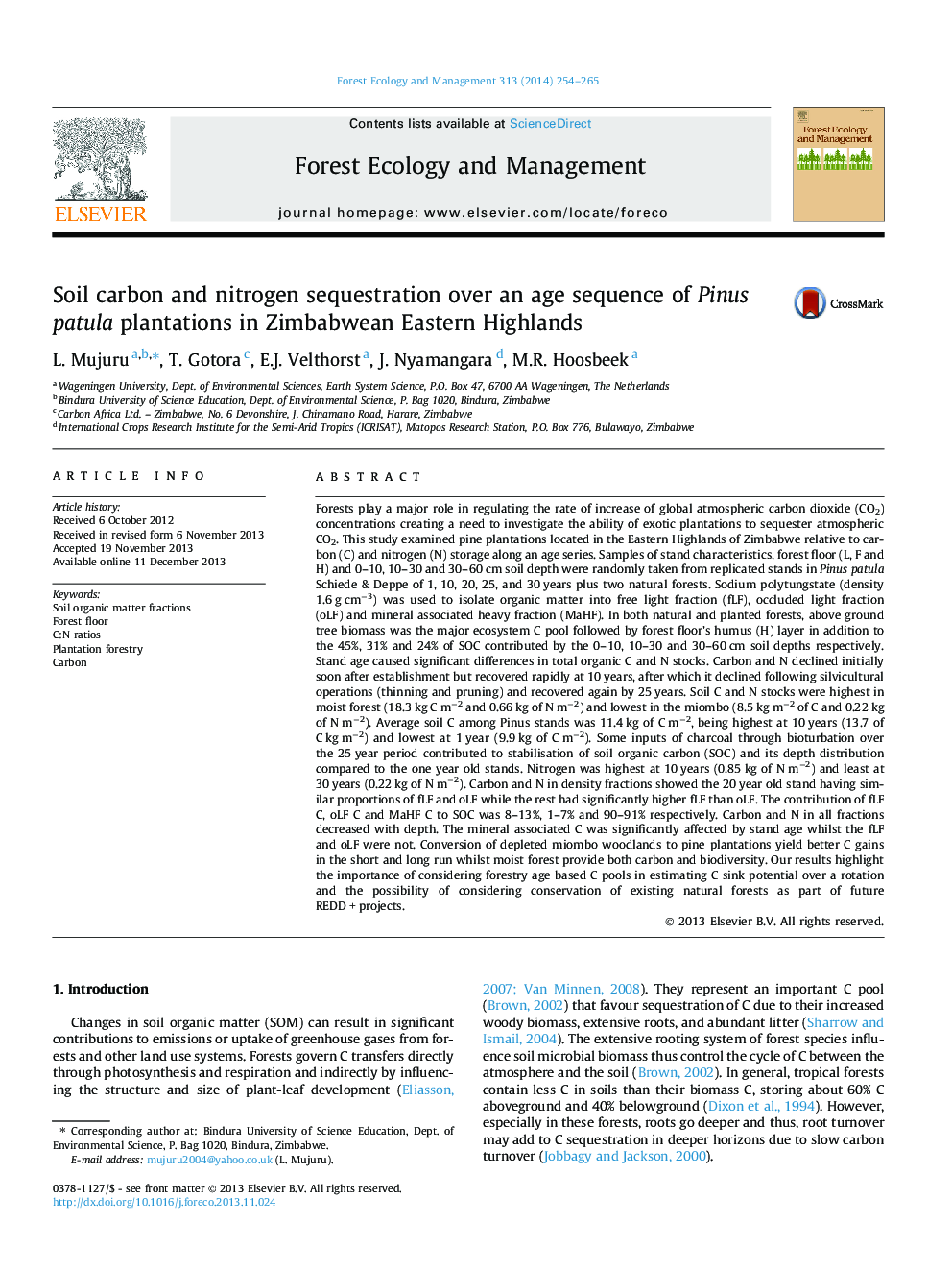| کد مقاله | کد نشریه | سال انتشار | مقاله انگلیسی | نسخه تمام متن |
|---|---|---|---|---|
| 86600 | 159199 | 2014 | 12 صفحه PDF | دانلود رایگان |
• Moist forests have higher C and N stocks than pines and miombo woodlands.
• C and N in forest floor varied by age and forest type dominated by H layer.
• Stand age caused significant differences in total organic C and N stocks.
• The MaHF contributed most to SOC (90–91%) and oLF least (1–7%).
• The MaHF C was significantly affected by stand age whilst the fLF and oLF were not.
Forests play a major role in regulating the rate of increase of global atmospheric carbon dioxide (CO2) concentrations creating a need to investigate the ability of exotic plantations to sequester atmospheric CO2. This study examined pine plantations located in the Eastern Highlands of Zimbabwe relative to carbon (C) and nitrogen (N) storage along an age series. Samples of stand characteristics, forest floor (L, F and H) and 0–10, 10–30 and 30–60 cm soil depth were randomly taken from replicated stands in Pinus patula Schiede & Deppe of 1, 10, 20, 25, and 30 years plus two natural forests. Sodium polytungstate (density 1.6 g cm−3) was used to isolate organic matter into free light fraction (fLF), occluded light fraction (oLF) and mineral associated heavy fraction (MaHF). In both natural and planted forests, above ground tree biomass was the major ecosystem C pool followed by forest floor’s humus (H) layer in addition to the 45%, 31% and 24% of SOC contributed by the 0–10, 10–30 and 30–60 cm soil depths respectively. Stand age caused significant differences in total organic C and N stocks. Carbon and N declined initially soon after establishment but recovered rapidly at 10 years, after which it declined following silvicultural operations (thinning and pruning) and recovered again by 25 years. Soil C and N stocks were highest in moist forest (18.3 kg C m−2 and 0.66 kg of N m−2) and lowest in the miombo (8.5 kg m−2 of C and 0.22 kg of N m−2). Average soil C among Pinus stands was 11.4 kg of C m−2, being highest at 10 years (13.7 of C kg m−2) and lowest at 1 year (9.9 kg of C m−2). Some inputs of charcoal through bioturbation over the 25 year period contributed to stabilisation of soil organic carbon (SOC) and its depth distribution compared to the one year old stands. Nitrogen was highest at 10 years (0.85 kg of N m−2) and least at 30 years (0.22 kg of N m−2). Carbon and N in density fractions showed the 20 year old stand having similar proportions of fLF and oLF while the rest had significantly higher fLF than oLF. The contribution of fLF C, oLF C and MaHF C to SOC was 8–13%, 1–7% and 90–91% respectively. Carbon and N in all fractions decreased with depth. The mineral associated C was significantly affected by stand age whilst the fLF and oLF were not. Conversion of depleted miombo woodlands to pine plantations yield better C gains in the short and long run whilst moist forest provide both carbon and biodiversity. Our results highlight the importance of considering forestry age based C pools in estimating C sink potential over a rotation and the possibility of considering conservation of existing natural forests as part of future REDD + projects.
Figure optionsDownload as PowerPoint slide
Journal: Forest Ecology and Management - Volume 313, 1 February 2014, Pages 254–265
